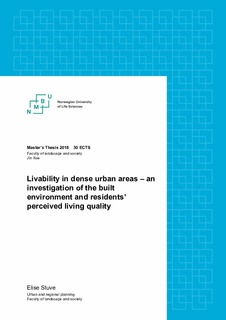| dc.description.abstract | In recent years, the direction of policies has changed towards an increasing focus on the compact city to ensure a more sustainable urban development. The municipality of Oslo clearly states that the future growth should be dealt with according to the compact city strategy, building denser and concentrating new development inside the existing boundaries of the city. However, there has been a growing discussion regarding the negative consequences of densification. A common perception is that dense living is less livable than low-density environments and seen as an undesirable long-term option. This is considered less sustainable. In countries like Norway, traditions and widespread preferences for a suburban lifestyle does not support this and studies investigating the relationship between densification and livability show mixed results.
The thesis sheds light on how the built environment of dense urban areas influence perceived living quality of residents. Furthermore, it aims at investigating and getting a better understanding of the preferences and thoughts of residents in three relatively new and dense neighbourhoods in Oslo. How to enhance acceptance for dense living and what qualities of dense living people value are important and urgent questions to investigate. This has been done by conducting in-depth interviews with 13 residents living in the three case areas; Sørenga, Kværnerbyen and Solsiden.
The results emphasise that the built environment is influential to perceived living quality in dense urban areas. Furthermore, it is not necessarily the density alone that leads to dissatisfaction among residents but rather the related factors of the dwelling, neighbourhood and larger area. There were factors such as good layout of the dwelling, balcony, high level of privacy, sunlight and view and good dwelling position. At the neighbourhood level diversity of facilities and mixed-use, attractive outdoor areas and enough greenery, architectural quality and the lack of traffic and noise were important. Having accessibility to recreational areas, workplace and public transport were essential at the larger scale. The qualities of the built environment and how these are organised determines the perceived living quality to a great extent. | nb_NO |

